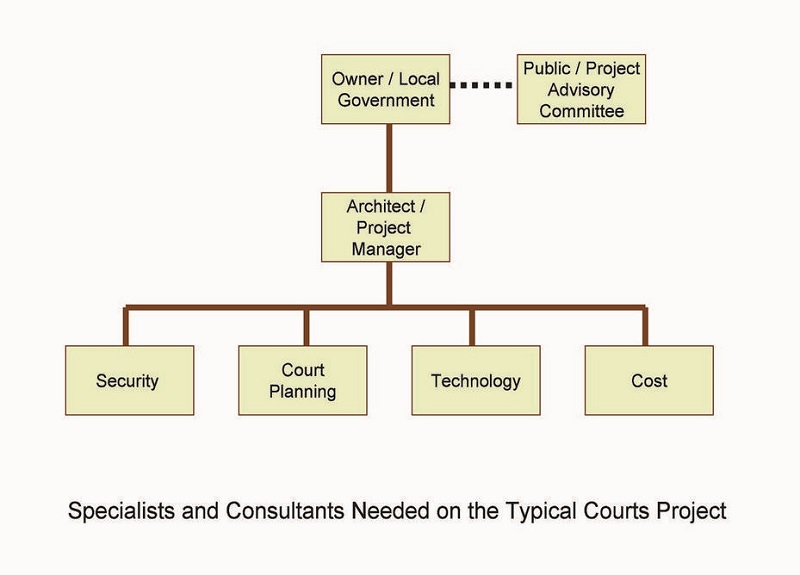Design Team
A typical design team will consist of a design architect, civil/structural/mechanical engineers, landscape architect, audio/visual consultant, acoustic consultant, security consultant or engineer, and a court consultant or court programmer. Other specialties that may be required depending on the project are a traffic engineer, IT or technology consultant, lighting consultant, or historic preservation architect or consultant. Most projects will also have a cost consultant involved from very early on in the project.
One of the first decisions to be made is when and how to retain outside consultants--planners, architects, engineers, and others. Should the local government or court do the initial feasibility planning on its own before retaining consultants and architects to perform programming and design tasks, or should consultants be hired to perform formal master planning in advance of architectural design? These questions are usually among the first to be addressed by a review and advisory committee.
Seek outside assistance for early strategic planning, unless the local governing body has unusually strong internal planning resources. Even with strong internal-planning resources, considerations of experience, time, and perceived objectivity also may influence the decision to seek early consulting advice. Groups such as the National Center for State Courts and the Academy of Architecture for Justice of the American Institute of Architects can provide lists of consultants.

Regardless of whether consultants are retained to perform planning services, or such tasks are performed by local staff, at some point space programming and design assistance will be required. In the wide range of available professional services, there are court consultants who specialize in strategic planning and space programming; architectural firms who specialize in the design of justice facilities; and a large variety of general practice architectural and engineering firms.
Team Structure
There are a variety of options for the structure a design team. A strong local architectural firm, if teamed with a specialist in court planning, can produce excellent results, while a combination of local and national design teams also can be effective, particularly in larger projects. Some local governing bodies are committed to supporting local businesses and deliberately seek to ensure that the major portions of a design project will be performed by (and fees paid to) a local architect. In such cases, specialized expertise is used only to augment the local firm. Other jurisdictions advertise nationally, wishing to attract large, or high-profile, out-of-town firms. In combining with local firms on a joint-venture design team, high‑profile firms may either take a subordinate role or perform as dominant partners, depending on particular circumstances of the project.
Regardless of how the planning and design team is assembled, it is important that it contain specialists in the following disciplines:
- Cost planning
- Security
- Acoustical engineering
- Electronics/audio visual
- Technology
Selection Process
Whichever preference prevails, it is important that the selection process promotes an informed choice among competing teams. Firms wishing to compete for a court design project should be judged on the basis of:
- Design strength for institutional or private-sector buildings with comparable character.
- Organizational and management strength with respect to projects of comparable size and complexity.
- Firm or team strength--specific experience of particular individuals to be assigned to the project.
- In-house subcontractor and consultant disciplines and qualifications.
- References--specifically related to individuals assigned to the project.
- Schedule and cost control mechanisms and history.
- Specific technical expertise, use of computer assisted-design, work approach, and management methodology.
- Overall team chemistry and "fit" with project staff.
There are many good architectural firms in the United States. On a large project, it is expected that nearly all of the competing teams will have the overall organizational and design strength necessary to perform effectively. In choosing among several competing firms or teams (choosing among at least three is recommended) jurisdictions should select on the basis of the specific expertise and experience of the individuals assigned to the project, as demonstrated by previous projects and references, and on the basis of the particular work approach and management methodology which seems to suit the jurisdiction and the project best.
Team chemistry also should be considered. Planning, design, and construction projects take several years to complete--particularly for complex facilities such as courthouses. Long working relationships should be comfortable ones to promote maximum results with minimum strain.